
How to write how-to articles?
The question might sound a little weird for some.
But if you take a moment and slowly think of the number of how-to articles that you scroll through daily, you might be able to re-think the weirdness.
If you are a blogger or a content writer, and if you write for businesses, the importance will be easily understood to you.
How-to articles are a popular form of articles mostly explaining a particular process and often intended at teaching the reader how to accomplish something.
This article will talk about how you can write how-to articles with ease and perfection.
Let’s look at the detailed steps, one by one.
How to Write How-to Articles: A Quick Overview
Here’s a quick overview of the steps that you need to follow to write how-to articles.
- Decide your topic & find how-to article ideas
- Pick the right keyword for your how-to article
- Understand the process inside out and collect data
- Outline your steps and divide them into sections and sub-sections
- Collect your images for each section
- Write and publish your how-to article
Now let’s go ahead and dig deep into each of these steps.
1. Decide your topic & find how-to article ideas
The very first thing that you have to do is decide on your main topic.
This topic can be a broad one, but you should be able to find article ideas from it.
Ideally, you should choose your topic based on your expertise.
For example, if you are good at digital marketing, you can go ahead and choose it as your topic.
When you write how-to articles, your knowledge and expertise in the topic will reflect in your content.
Just in case if you don’t have much expertise in the topic, you will have to spend more time researching.
Once you have finalized your main topic, you can start looking for article ideas.
To find article ideas, you can make use of a tool like Answer the Public. It is a freemium tool and even the free version can help you find how-to article ideas to some extent.
You can go to answerthepublic.com, enter your main topic there and click search.
Just for the demonstration purposes, I have entered the topic ‘learn digital marketing’ in the search here. (see below image)
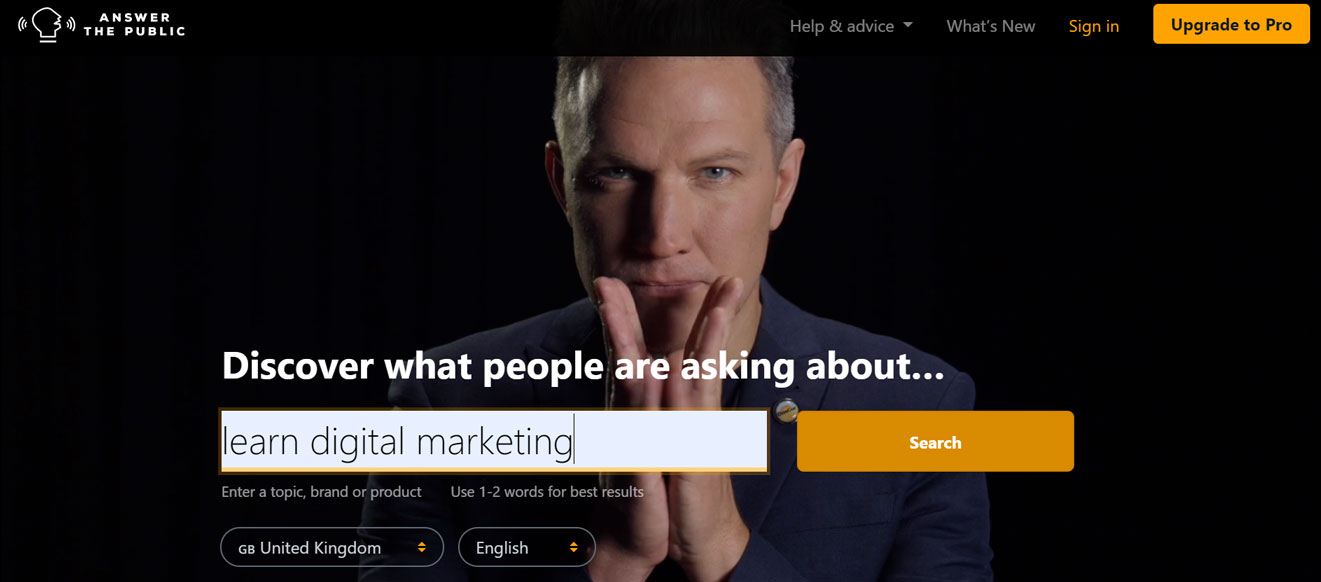
This will show you all the questions that people are asking about your topic. (see below image)
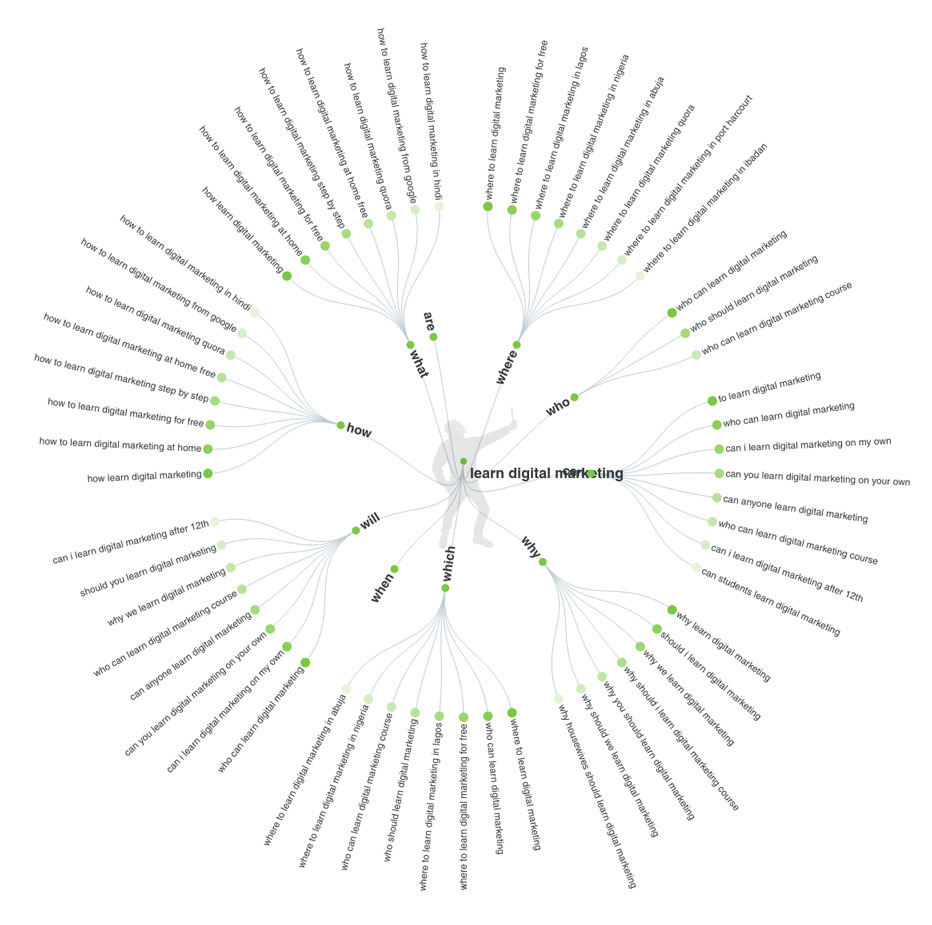
In the above visualization, you can see that I have generated all this set of questions for the term ‘learn digital marketing’ that I have entered.
You can either see these questions as a set of visualizations (like the one above) or as a list of questions (see below image).
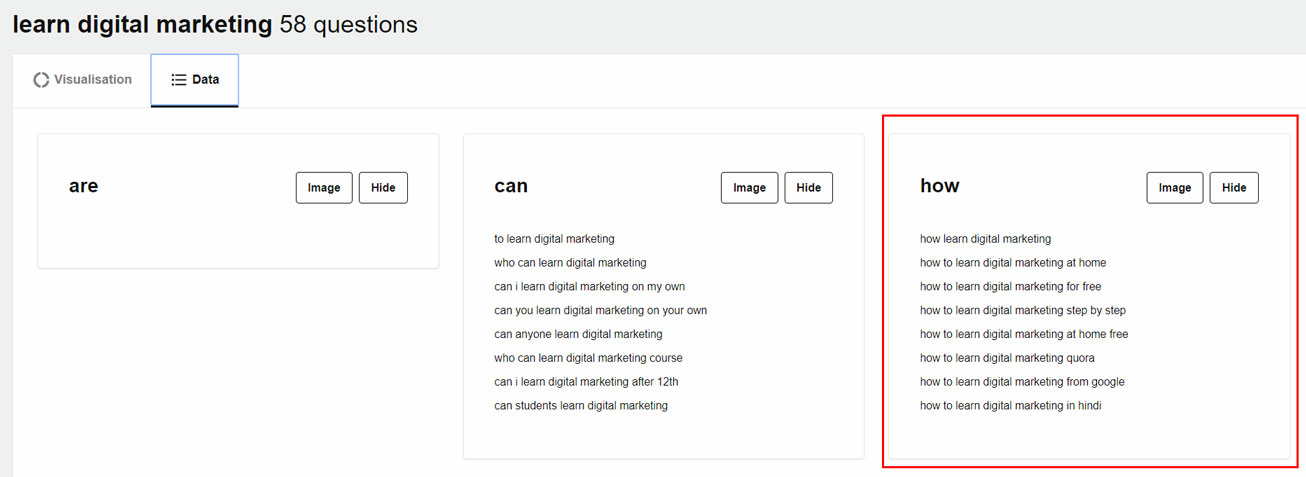
From this, you can get a set of how-to questions that can be turned into article ideas. Answer the Public collects this data from Google search and these questions are the ones asked by people across the world on the web.
2. Pick the right keyword for your how-to article
Before writing any how-to article that has to go live on the web, you need to perform extensive keyword research.
Ideally, you will have to find one focus keyword for each of your articles. Your article can then be optimized to rank for this keyword on search engines like Google.
Here are a few reasons why you need to perform keyword research.
- Keyword research will help you find popular terms that are being searched by people across the web.
- It will help you find keywords or search terms that are easy to rank for on Google.
- Eventually, it will help you in ranking your articles on Google search results.
We already saw how Answer the Public is going to give us how-to article ideas. Usually, these how-to article ideas are questions that start with a how-to.
But how do you know which how-to question to choose for your article?
That is where we need to apply some keyword research practices.
Ideally, we should look at the popularity of questions shown by Answer the Public and pick a few of them. These questions can then be turned into how-to article ideas.
There are two ways to check the popularity of the questions within Answer the public.
- Use a browser extension (Chrome/Firefox) like Keywords Everywhere that will show you the monthly search volume of each question next to it. (see image below)
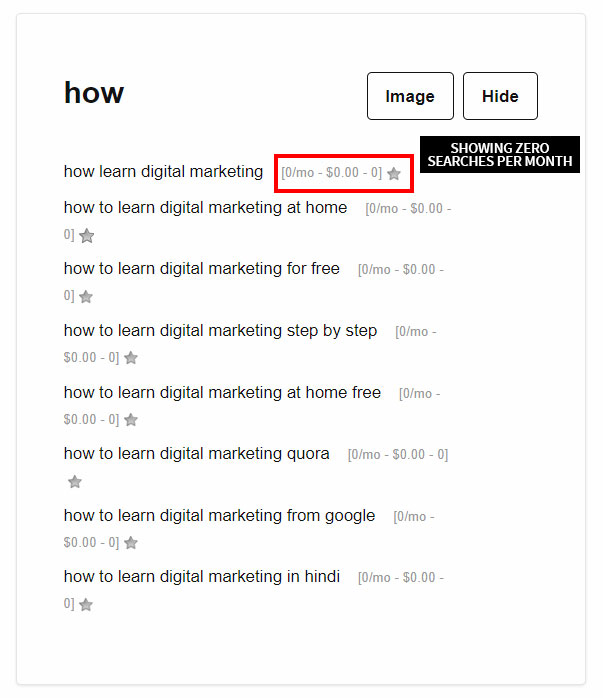
As you can see in the image above, you may not always get the accurate monthly search volume of these questions using Keywords Everywhere. Though you can get it for some questions, some of them will always end up showing zero searches per month.
In reality, these questions have lower monthly searches, and it is not always zero.
This shows using Keywords Everywhere browser extension with Answer the Public is not always reliable.
But there is an alternative, which is the second option given below.
2. Follow the green dots on Answer the public. The darker green dots indicate a more popular topic. (see image below)
If you go to the ‘data’ option under a topic in Answer the Public, you can click on the ‘image’ button to get a snapshot of the questions. This snapshot will have green dots marked against each of these questions. A darker green dot indicates a more popular topic and a lighter green dot indicates a less popular topic.
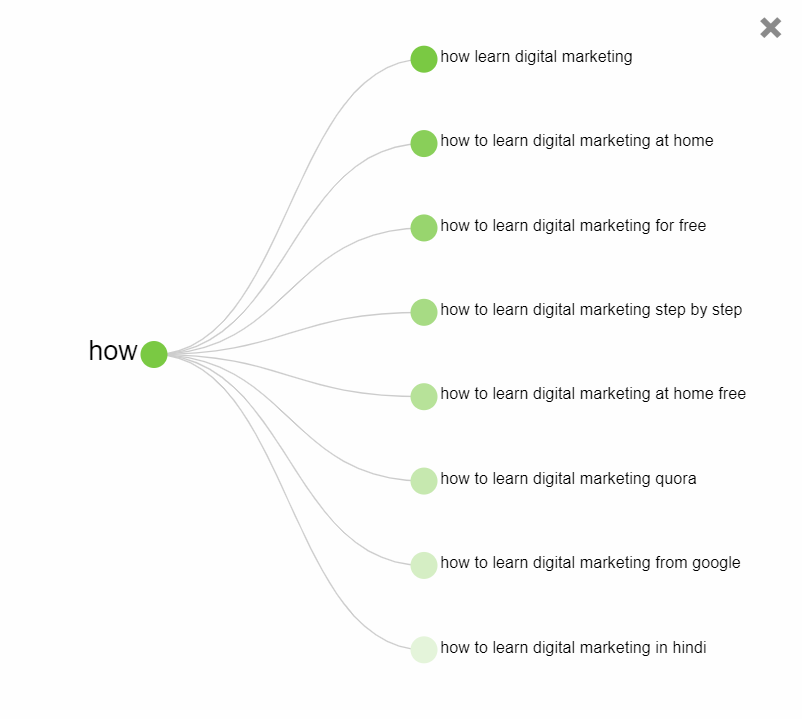
To refine the questions based on search volume again, you can pick one of the popular questions (based on the green dot) and enter it into another keyword research tool. You may use a tool like Ubersuggest or SEMrush’s Keyword Magic tool to get the details.
Ideally, you should be considering the below aspects to pick a focus keyword for your how-to article.
1. Monthly search volume
This is the number of searches performed in a month for a particular keyword. Usually, a more searched keyword will have more competition.
2. Keyword difficulty (SEO Difficulty)
A metric shown by keyword research tools considering the competition. It is normally a score that ranges from 1 to 100, where 1 indicates a very easy keyword to rank, and 100 indicates a very difficult keyword to rank on Google search. This is calculated based on the strength of competing sites for a particular keyword.
You can also check out this detailed guide on keyword research for more information.
In reality, there are more factors than these 2 to consider. But in the context of a how-to article, these 2 aspects are the most important.
As an example, if you are picking a question like ‘how to learn digital marketing’ to turn it into an article, you could use ‘how to learn digital marketing’ as the focus keyword if it satisfies the criteria like adequate search volume and medium or low keyword difficulty.
If you follow the above method, you will be able to find the right focus keyword for your how-to article.
Now, let’s move on to the next step.
3. Understand the process inside out and collect data
In most cases, when you are writing how-to articles, you will be explaining a process in it. And you will be breaking down the process into multiple steps to make your readers understand it easily.
Let’s look at the example of this topic ‘How to prepare Kerala style fish curry?’
In this case, the article should explain the utensils needed, ingredients, preparation methods, time duration, practical tips, serving methods etc. Only then, it will be useful to the readers.
When you explain any process step by step, your readers can follow these exact steps to make it work for them.
As a writer, before starting any how-to article, you should well understand the process that you are going to write about. And you should be collecting maximum data about it to include in your how-to article.
In most cases, you can include the following aspects in your how-to article while you explain a process.
- The tools/facilities needed
- The process flow
- Practical tips
- Timeline/duration
- Measurement of success
- Feedback & improvement options
Though it can vary from process to process, these are more or less the common aspects that you can focus on.
Also, to make your how-to article more credible, you can include the following sections as well.
- Related statistics
- Real-life examples
- Credible references
- Well-known quotes
- Process definitions
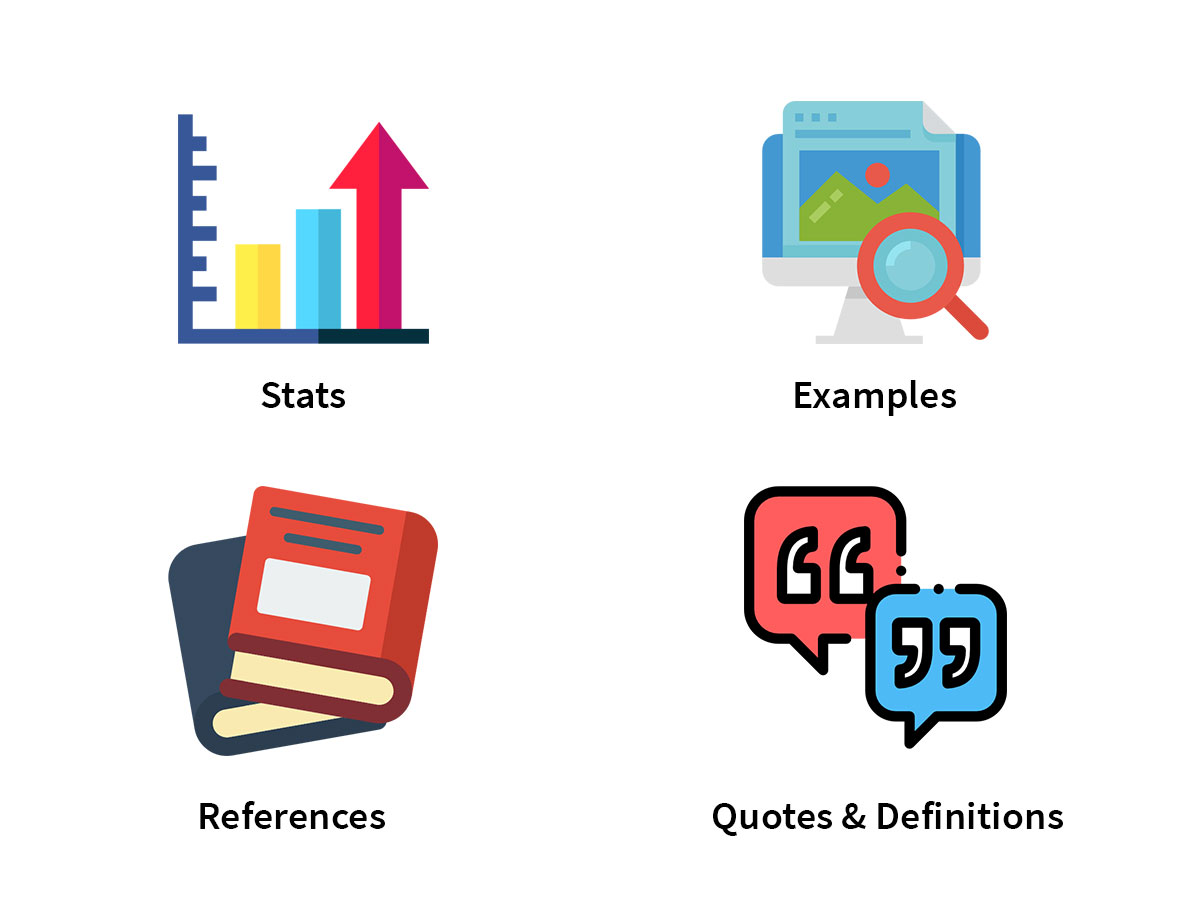
Whenever you take references from another source, make sure it is a credible one and always provide a link to them or mention courtesy.
4. Outline your steps and divide them into sections and sub-sections
Once you have understood the process completely and have all the data needed, you can go ahead and outline the major steps in your how-to article.
Writing down an outline will give you an organized picture of the article in your mind.
Normally, when I prepare an outline for a how-to article, I follow the below pattern.
- Introduction
- Step 1
- Step 2
- Step 2.1
- Step 2.2
- Step 2.2.1
- Step 3
- Step X
- Conclusion
And based on the outline that you have prepared, you can divide your main steps into sections and subsections. (see above example)
Once you have your outline ready, it will be easier for you to develop on each point in the outline and make it into complete sections and subsections, and finally an article.
Now, let’s again look at the same example of ‘How to prepare Kerala style fish curry?’
The major steps in this article would include collecting the necessary ingredients, cooking process and serving methods.
However, you can subdivide the cooking process into multiple steps. Similarly, you can make small sections to describe each of your ingredients as well.
5. Collect your images for each section
A how-to article should always contain the right images.
Without images, your article may not be helpful to the readers.
Ideally, while creating the outline for your article, you can note down the images that are required.
According to your topic, you may include the following.
- Real photographs explaining the process
- Screenshots explaining how-to work on something
- Graphs and charts associated with statistics
- Process flow diagrams and mindmaps
While adding images to your how-to article, there is no right or wrong. But your focus should be on making your reader understand the topic effortlessly.
Ideally, the images that you are adding, should be relevant to your topic. Try to add images corresponding to each section or subsection, as this will make it easy for your readers to understand the process that you are covering in your article.
Importantly, make your images simple, direct and easily understandable. In the case of how-to articles, abstract images may not be of great help.
6. Write and publish your how-to article
Once you are done with the above 5 steps, you can go ahead and start writing your article.
As it is a how-to article, you should pay attention to making it as simple as possible. Because the whole aim of this article here is to make someone understand a process or a topic.
And essentially, we are teaching someone how to do something, so it has to include everything that is necessary to make him understand the topic.
Normally, you can start with an introduction, where you can talk a bit about the importance of the topic that you are covering. Once that is done, you can go ahead and start with your step by step process, one at a time.
It is better if you assign numbers to your steps, as it will be easier for your readers to keep track on the process that you are explaining and the various steps.
And make sure you are adding all the relevant sub-sections, diagrams, quotes, stats and references to make it easier for your readers.
Then you can finish your how-to article with a conclusion giving a gist of all the points that you have covered in previous steps. This will give your readers an overall picture of the process.
Also, if you have 2 to 3 very important points, you can throw some light on them in the conclusion part. This will help your readers to keep those points in mind when they finally try to do the process that you explained in the article.
Conclusion
That’s it, folks. For most of you, writing a how-to article won’t be a tedious task. But in case if you have a doubt on what to add or how to write a how-to article, this small guide should help.
The one important point to keep in mind is, a how-to article is meant to teach your readers something. So make it as simple as possible.
And if you are explaining a complex process, make sure you break it down into various small parts. So that it will be easily digestible to your readers and will help them carry out the process that you have covered in your article.
Hope this article was of help. Don’t hesitate to leave a comment below if you have a query or feedback.
Leave a Reply